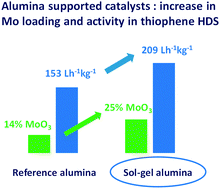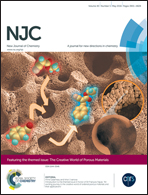Potential of templated mesoporous aluminas as supports for HDS CoMo catalysts
Abstract
Aluminas, exhibiting different textural properties, were prepared using a template assisted sol–gel method. In the presence of a triblock copolymer as a porogen, and owing to the control of the synthesis parameters, alumina textural properties can be adjusted up to values higher than those of conventional alumina. Among obtained supports, some were selected in order to cover surface area values from 350 to 450 m2 g−1, and pore diameters from 5.4 to 9.0 nm. CoMo derived catalysts, prepared by impregnation with a (Co2Mo10O38H4)Co3 solution, with a concentration corresponding to a molybdenum density of 4 atMo nm−2 (or 3 when not possible to achieve 4), exhibit decreased textural parameters. However, despite the changes induced by the preparation step, the final catalysts always display attractive textural properties. Activities in thiophene hydrodesulfurization (HDS) can be increased by a factor three, depending on the textural properties of the supports used and possibly to some extend on the residual carbon content in the material. The performance of the most efficient solid in the HDS of thiophene was evaluated in the HDS of a straight run gas oil (SRGO) and was found higher than that of a commercial alumina based catalyst and close to that of a commercial catalyst modified by a chelating agent, evaluated under the same conditions.

- This article is part of the themed collection: The Creative World of Porous Materials

 Please wait while we load your content...
Please wait while we load your content...